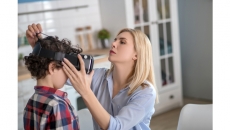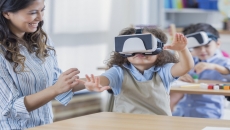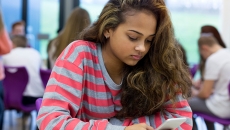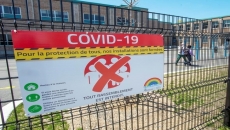The ongoing pandemic has put masks and sanitizers on back-to-school shopping lists, but several parents, teachers and school staff are hunting for even more unusual materials: cut logs for the schoolyard, tarps to shield soccer pitches from sun and rain, and cheap yoga mats for outdoor seating.
With many school plans failing to promise smaller class sizes and epidemiologists noting less infection risk outdoors, an ardent movement of teachers, parents and sympathetic principals are urgently pursuing ambitious outdoor learning plans they hope can be incorporated into the curriculum.
Toronto mom Anna Galati says teachers at her inner city school Sprucecourt Public School have been collecting supplies since March in anticipation of more outdoor programming in the fall, with the parent council heeding a call in recent weeks to help source last-minute items.
"Like everybody, we're all kind of winging plans," Galati says of frenzied organizing, which include efforts to address safety concerns and brainstorm ways to help needy families stock up on rain and winter gear.
"We're going to try and get as many kids outside for as much of the day as possible and go for as long as we can."
At an anglophone school in Gatineau, Que., principal David McFall says he dropped $3,000 of his own money on three party tents in July worried they might sell out by September, despite not knowing whether they would be used at his school.
"It's one of the things (where) yes, you have to buy the tents upfront and on your own, and then you talk to your director and you get approved," says McFall, who was ultimately permitted to use the tents at Pierre Elliott Trudeau Elementary School.
"It was a calculated risk."
THINKING OUTSIDE THE CLASSROOM
The idea of shifting lessons from the classroom to the soccer pitch has evolved quickly from a private school perk to a priority for many public schools increasingly worried about the ventilation and distancing space required to mitigate COVID-19 spread, says outdoor education expert Adam Bienenstock.
He says that's reflected in the changing clientele of his Dundas, Ont., company Bienenstock Natural Playgrounds, now rolling out log-based outdoor desk-and-chair sets designed for quick installation in multiple configurations.
Bienenstock counts 187 pending sales since launching the product in Canada six weeks ago, including orders from schools and boards in British Columbia, Alberta, Saskatchewan, Ontario, Quebec and New Brunswick. Orders are also being filled in Florida, California, Texas and New York.
This month, the company is installing 14 custom outdoor classrooms in northern Ontario from Wawa to Sudbury, he says. That'll be followed by installation of 16 classrooms in the province's southern half.
"Outdoor classrooms up north has become a thing — the irony of that, of course, is not lost on me," he chuckles on a recent call from the Lake Huron area where he was working on several jobs.
"For everyone in southern Ontario, the main concern that people have is the weather and yet we're selling to where it goes to -25 (Celsius) on a regular basis."
Bienenstock says he began worrying about the impact of COVID-19 back in December, when he was first alerted to a possible pandemic by his father John Bienenstock, a renowned expert in mucosal immunology and director of the Brain Body Institute at St. Joseph's Healthcare in Hamilton.
He's been selling amphitheatre-style outdoor learning set-ups since 1989, but began plotting ways to convert his log-and-boulder play structures to rugged outdoor desks and chairs in the spring.
Each "student station" is comprised of two logs cut to chair- and table-height that are fastened together. Each weighs about 136 kilograms to avoid tipping and the need for anchors. The basic system comes with a taller station for a teacher and a two-sided blackboard, and costs $7,500 to $10,000 for a standard setup of 15 to 20 students.
Despite strong interest, Bienenstock says signing up boards and schools typically involves a lengthy, bureaucratic procurement process and so some parents have skirted those hurdles by sourcing their own logs for cheaper and less-complicated seating areas they can install themselves.
A COMMUNITY EFFORT
Galati says an arborist has agreed to give her school free tree trunks that can be used as outdoor seating, but efforts to collect other donated items including tarps and yoga mats were unsuccessful.
She expects gaps will be filled by families willing to buy those items for the class. For that reason, she worries the spectrum of ad hoc ventures will deepen inequities between schools with more affluent families and those with greater needs, such as Sprucecourt.
Galati says some parent councils are donating to schools in need — her family was among those to receive food vouchers bought by parents at a neighbouring private school when the pandemic halted learning in the spring. She expects food insecurity will be an issue again this fall.
"One of the things we've discovered is that we won't be allowed to have our nutrition programs running so there'll be no breakfast, lunch, or snacks, which is a huge issue in our neighbourhood."
As an Indigenous woman, Galati says she hopes outdoor learning experiments will include land-based teachings, which use an Indigenous and environmentally-focused approach to education that addresses physical and spiritual connections to the land.
She sees a new willingness to rethink the classroom as an opportunity "to decolonize education and move away from our typical Western model, which would typically be just putting desks and chairs outdoors."
But she also recognizes safety issues with moving kids outside, especially in her neighbourhood where there has been gun violence.
"There's also a lot more mental health issues and substance use we're seeing in the community, so in our local playground we've been finding a lot more needles and pipes and stuff," says Galati, whose kids are ages 5 and 11.
"There's some youth that I've spoken to that are actually scared to be outdoors in the outer playing area."
While some families scramble to help expand capacity to learn outside, one parent leading much of the back-to-school advocacy in British Columbia's largest school district believes outdoor learning should be less of a priority than assuring a robust remote learning program for kids unable to attend in-person class.
Rina Diaz of the Surrey District Parents Advisory Council questioned the value of outdoor learning if those same kids would still be exposed to infection risk by indoor classes, busing to school, and extracurricular activities.
"It doesn't matter where you put the children. It could be outside, it could be inside," Diaz says. "Exposure is exposure, no matter how you put it."
MOVING THE WORKOUTS OUTSIDE
Because school gyms have been deemed off-limits, Nova Scotia's back-to-school plan encourages outdoor classes, but especially for physical education.
The Chignecto Central Regional Centre for Education, which oversees 67 schools in central and northern Nova Scotia, is rolling out a Natural Outdoor Seating project to support schools eager to get students and teachers outside.
So far, region spokeswoman Jennifer Rodgers says Harmony Heights Elementary and Truro Junior High School have set up logs, stumps and milled beams as benches for multiple classes. She says the remaining 65 schools will receive information on their options this week.
Back in Gatineau, McFall expects students at his school will likely be outside for gym class, in addition to three 25-minute outdoor recesses, plus a 25-minute outdoor lunch.
He'd like teachers to attempt at least 50-minutes of instruction time outdoors but says such goals have yet to be discussed and that he's loathe to set daily minimums.
McFall also bought 20 bikes for class trips and has asked the Home & School Association to fundraise for more bikes, helmets, and kickstands, as well as scooters for the younger kids.
"If you take away all the sports and all the clubs and a lot of the fun of school, there's not a lot left for kids. so you have to start to look at what would be really fun for a kid?" says McFall.
"Imagine going with their class on a bike on an excursion for half a day. I can't think of anything more fun than that."






